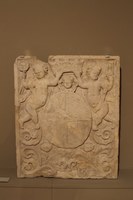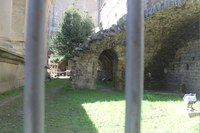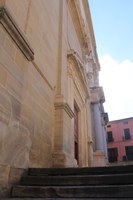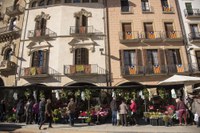
Vic was founded in the later Roman Imperial period, in the 1st century AD. The Romans defeated the Ausetan Iberians and destroyed their ancient capital, Ausa (probably located at the present-day Esquerda site, in Roda de Ter). During the subsequent process of occupation and Romanization of the territory, the Romans chose one of the hills near the Mèder River to establish a new tributary city which they named Auso and which served as an organizational, administrative and ecclesiastical centre. Proof of its importance is that it became a municipality and a temple was built at its highest point. Auso was an episcopal see in the Visigothic period and is thought to have been destroyed when the Moors arrived in the early 7th century AD.
The arrival of the Carolingians in the 9th century led to the repopulation of the Vic Plain. The ancient Roman city of Auso was rebuilt in around 878 following the creation of the county of Osona by Count Wilfred the Hairy. Only the walls of the Roman Temple remained and these were used to build the castle. The new town was named Vicus Ausonensis, meaning suburb of Ausona, from which the name Vic derives. The rebuilding process entailed the restoration of the episcopal see and the construction of the cathedral in the lower part of the city. In 1038, Bishop Oliba consecrated the Romanesque cathedral, of which the crypt, the bell tower and some of the buildings near the cloister assigned to the canons have survived.

The privatisation of public power in the Middle Ages led Vic to be split in two, with one area of the city initially under the jurisdiction of the bishop (transferred to the king in 1316) and the other under the jurisdiction of the Lords of the Castle, the Montcada family. This division had a significant impact on the life in Vic in the Middle Ages. At this time the city grew around the cathedral, the castle and the Mercadal (Market Square) and was encircled by a wall with towers, rebuilt in the 14th century. In 1450, the part of the city under the control of the descendants of the Montcada family was bought from them by King Alfonso the Magnanimous.
The city fell into a period of stagnation as a result of the crisis of the Late Middle Ages, fighting between rival political-civil-military factions (especially the Nyerros and the Cadells) and the wars with France. The defeat of Archduke Charles of Austria in the War of the Spanish Succession in 1714 threw Vic into chaos, since the city had supported him from the beginning.

The economic and demographic upturn of the 18th century led to the growth of the city. Important sculpting and architectural workshops opened, enabling the construction of several civic and religious buildings, along with the cathedral we see today.
In the 19th century, the city suffered from the effects of the Peninsular War and the Carlist Wars, not to mention the economic crisis which led many factories to relocate to the Ter Basin. Nevertheless, the city recovered thanks to various factors, not least the construction of the railway between Vic and Barcelona in 1875. This was also a period of strong cultural repression due to the influence of the Seminary, which revived the tradition of the mediaeval cathedral school and of the 17th-century Literary University of Vic. The many illustrious students of the Seminary include Jaume Balmes, Sant Antoni Maria Claret or Jacint Verdaguer. Thanks to the work of associations such as the Literary Circle or the Esbart de Vic (group of young poets), of which they were prominent members, Vic was able to play a significant role in the literary and political renaissance of the country.

Following the disruption of the Spanish Civil War and the stagnation of the post-war period in the mid-20th century, the city gradually recovered its traditional importance in Catalonia.





Social networks